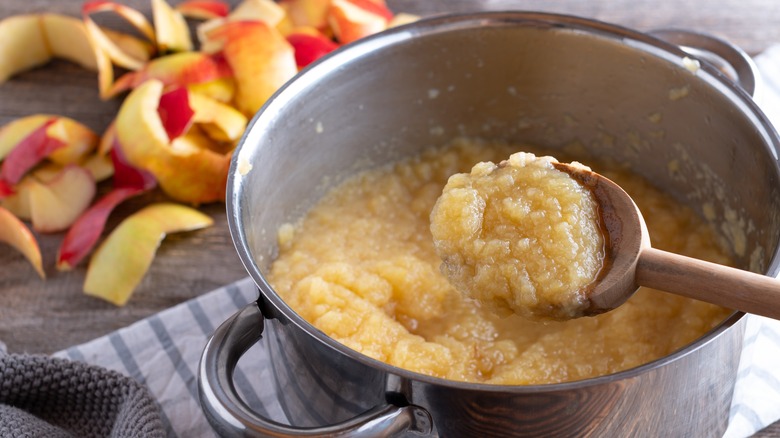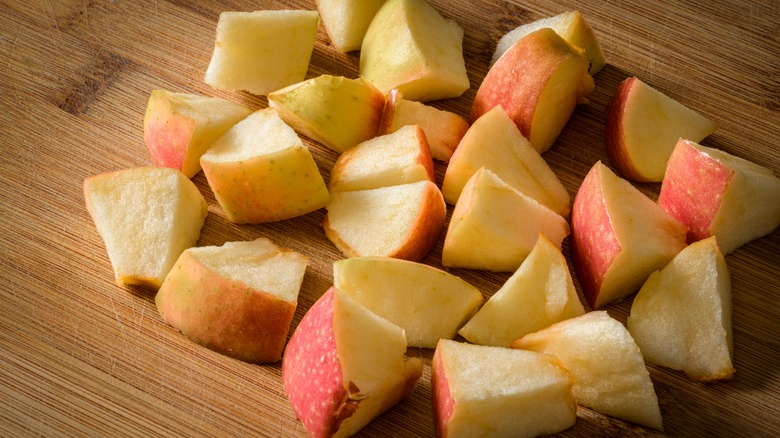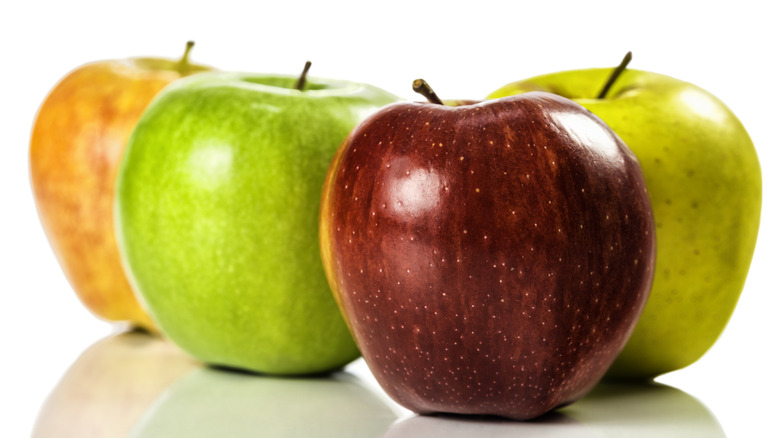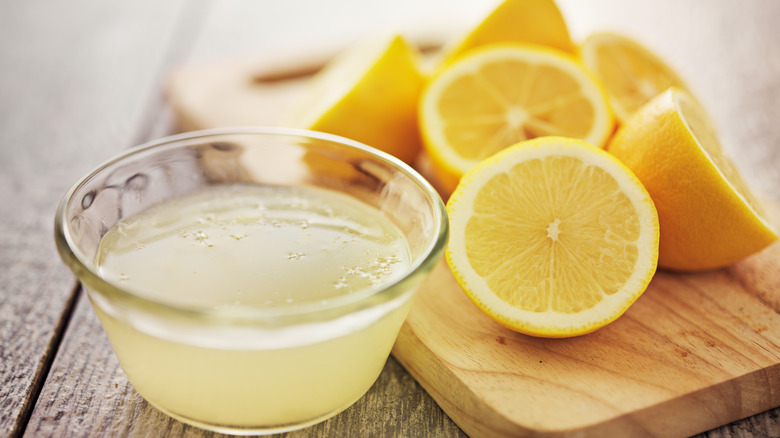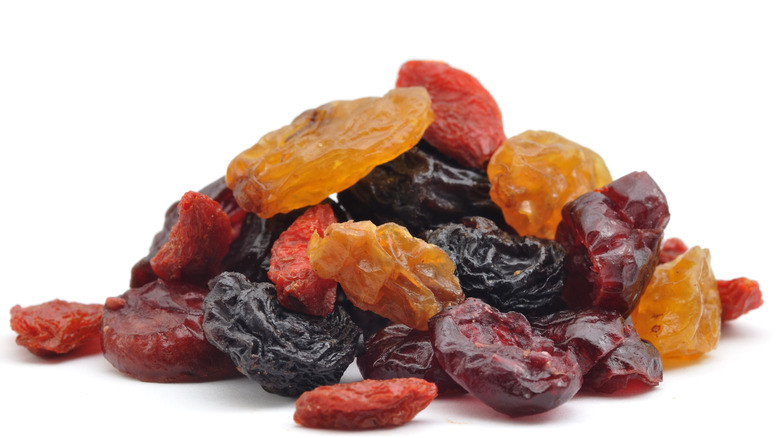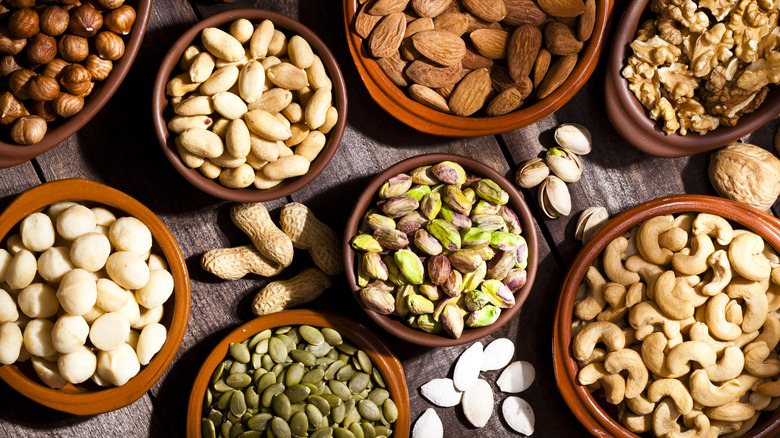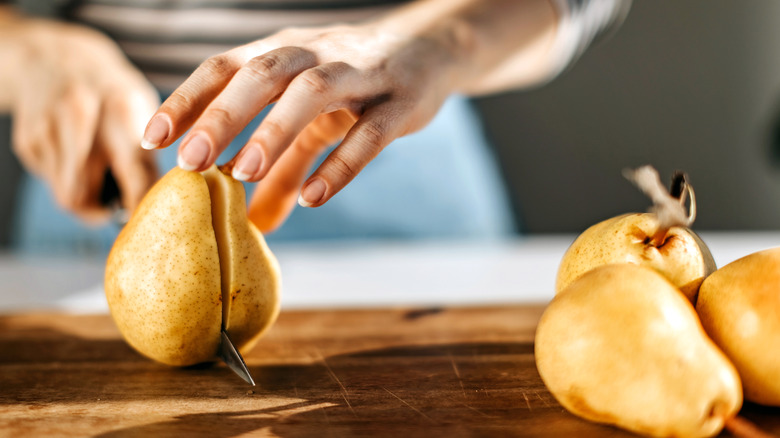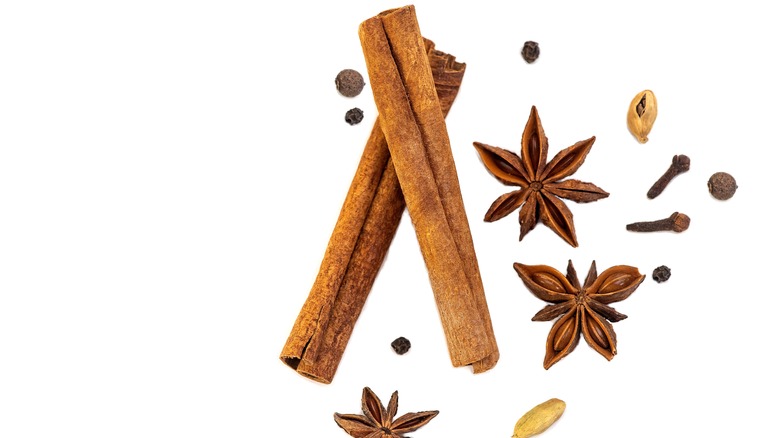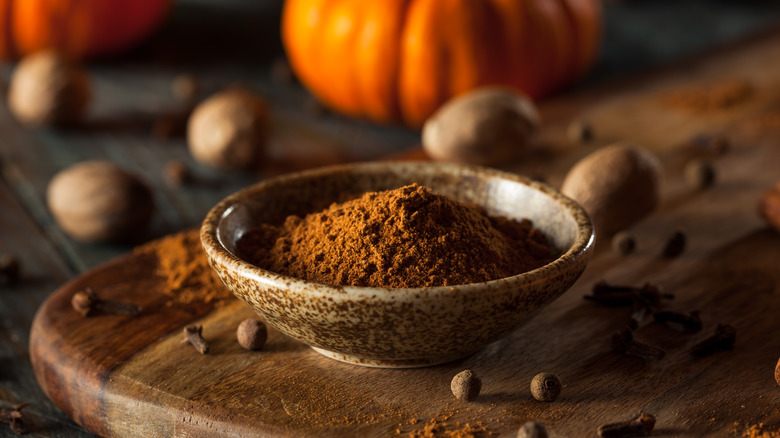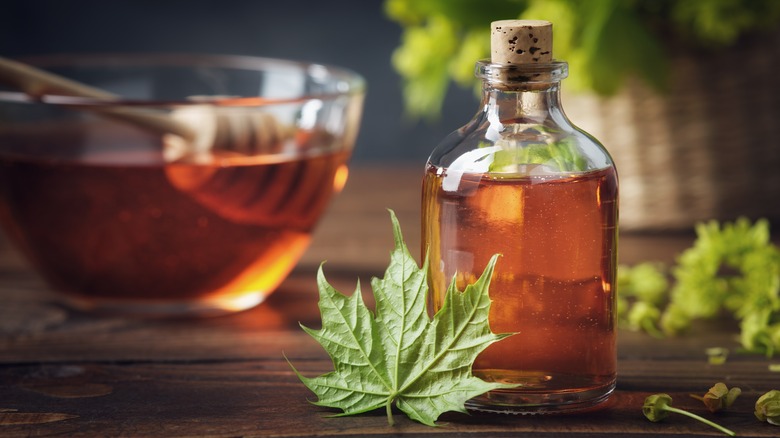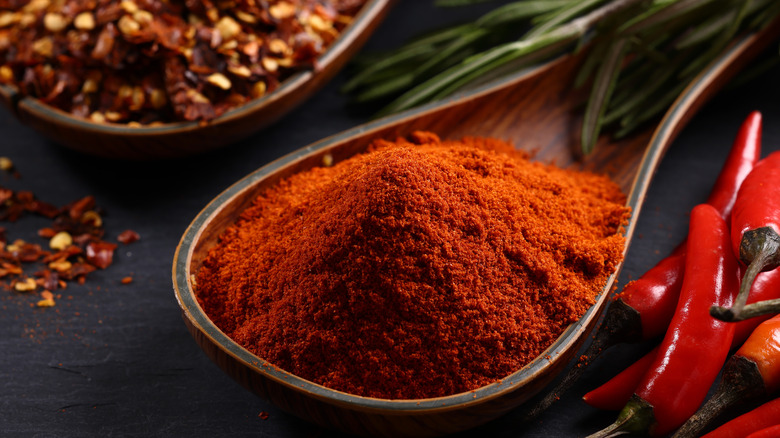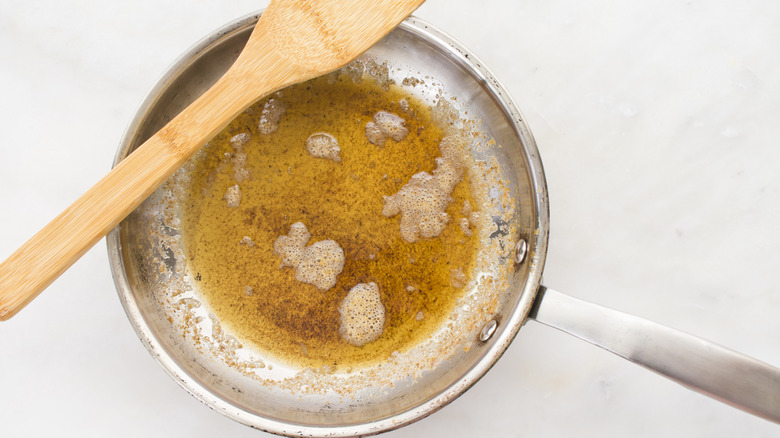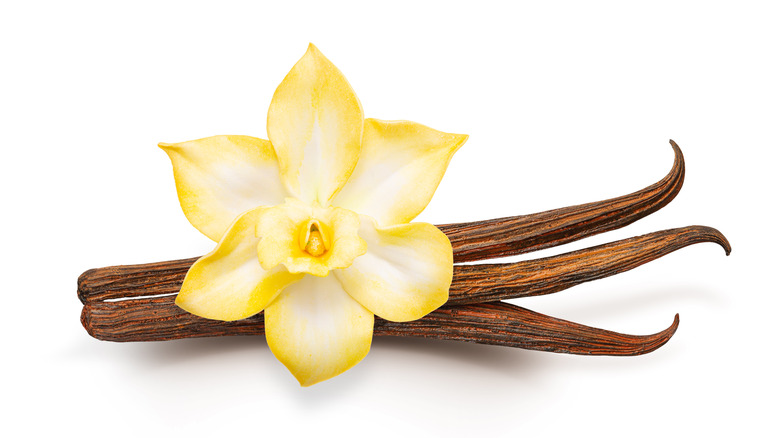13 Ways To Add Flavor To Applesauce
Whether it's the warm, comforting flavor of applesauce or its ability to pair seamlessly with other autumnal flavors (cinnamon, nutmeg, allspice), this favorite of multiple generations is an undeniable autumn staple. Besides that, its versatility and nostalgic appeal make it a fall recipe worth reaching for again and again. But as much as folks love this fruity purée, it's not exactly the most exciting snack out there.
Thankfully, there are plenty of delectable ways to take applesauce to the next level. From side dishes to something residing more in the spotlight, complementary tastes to crave-worthy treats, treating applesauce like a canvas on which to paint with flavors and textures rarely disappoints.
Below are 13 ways to boost its flavor, from simple cooking hacks and unique spice combinations to unconventional mix-ins that introduce new tastes and textures. Ready to upgrade that sauce and tantalize some tastebuds? Follow along as we explore the wide world of jazzed-up applesauce.
Keep the skins on
When making homemade applesauce, first instinct may be to remove every trace of skin. After all, most people think of applesauce as a smooth culinary delight, not a crunchy minefield. While there's certainly nothing wrong with removing the peel (if that's your prerogative), not only is it unnecessary, but it robs applesauce of some serious color, texture, and flavor.
If making applesauce with red apples, the skin will lend a pleasant pink hue to the final product. When it comes to texture, the naturally occurring pectin from the skin gives homemade applesauce a creaminess not unlike that found in the store-bought variety. In terms of flavor, peels add enough pleasant bitterness to cut through applesauce's sweetness.
Still not convinced that keeping apple peels on is the right move? If not for flavor or texture, do it for the health benefits. Apple skins contain folate, vitamins E and K, iron, calcium, potassium, and fiber (per Livestrong). They're also full of both soluble and insoluble fibers, meaning you'll feel fuller for longer and have an easier time digesting.
Try a variety of apples
Including multiple apple varieties in an applesauce recipe is crucial for one main reason — it helps ensure that the final product toes the line between acidic and sweet. Using just one type of apple makes achieving this delicate balance nearly impossible, but mixing apple varieties puts applesauce greatness easily within reach. Thankfully, it's pretty hard to go wrong when it comes to selecting the best apples for applesauce.
If the goal is applesauce that leans on the softer, sweeter side, consider using a mix of apples that fit this description. These include Gala, Golden Delicious, and Honeycrisp, just to name a few. To make a more tart applesauce, experiment with varieties like Braeburn, Rome, and Pink Lady. The ultimate applesauce recipe, however, would contain a blend of sweet, tart, and crisp apple varieties. For instance, you could combine a sweet Golden Delicious with a tart Rome and some crisp Jonathons to create a complex, well-rounded applesauce that appeals to a variety of palates.
Lemon juice is a non-negotiable
Those who have whipped up homemade applesauce know just how important it is to add lemon to the recipe. But just because it's essential doesn't mean its inclusion makes sense. Honestly, the first reason is purely an aesthetic one. Sprinkling chopped apples with lemon juice prevents the flesh from browning when exposed to air.
Looks aside, the acidity from the lemon juice helps brighten the earthy apple flavors while simultaneously balancing out their sweetness. Lemon juice acts as a natural preservative, meaning the applesauce stays fresher for longer. There are two techniques worth taking advantage of when it comes to the miraculous flavor benefits of lemons. The first is to cook chopped apples with water, lemon juice, and a sweetener. Alternatively, cook lemon slices (make sure to remove the seeds) with apples until they soften. Remove the lemon slices and blend the sauce; it's the perfect pairing.
Dried fruits add lots of natural sugar
Most applesauce flavor boosters focus primarily on ingredients to add during the cooking process. But how can flavor be added to applesauce after it's made? Even better, how can some zing be injected into store-bought applesauce? The answer is simple: by stirring in dried fruits. Used strategically, dried fruits can help balance out missing applesauce notes.
For example, an overly sweet applesauce benefits from the addition of tart dried cranberries, currants, or cherries. On the other end of the spectrum, sugary golden raisins can help tone down tartness from applesauce made with Pink Lady or Granny Smith apples. Experiment with adding dried fruit to applesauce, but be sure to recognize that some fruits pair better with this particular base than others. While tropical fruits like mangos, papaya, and coconut are undeniably tasty, keep them away. Their flavor profile simply clashes too much with that of apples.
Seeds and nuts give even more fall vibes
With its natural sweetness and subtly spicy undertones, applesauce is the quintessential fall treat. More than a simple purée, it exudes warmth and comfort, every spoonful evoking memories of orchard-strolling days gone past. That kind of flavor experience is pretty magnificent on its own, but for those serious about transforming the humble dish into a seasonal masterpiece, think about adding nuts and seeds.
Pepitas, walnuts, and slivered almonds harmonize with the flavors found in applesauce, adding a surprising crunch, a nutty warmth, and an unexpected earthy richness. If pressed for time, feel free to stir raw nuts and seeds directly into the bowl. Got a few minutes to spare? Toast add-ins before combining them. Exposing nuts and seeds to heat for just a few minutes intensifies their nutty flavor and makes them crunchier, ensuring they remain crispy until the last bite.
Pears pair well
Everyone knows apples are the heart and soul of applesauce; it's right there in the name, after all. But what if adding another fruit into the mix could substantially increase the flavor? Swap a few of the apples in any recipe with another beloved fall fruit — pears — and watch that sauce soar.
Like apples, pears are full of natural sweetness, making them an easy one-to-one substitute. Pears are so sweet, in fact, sugar could be bypassed altogether. Besides their delightful natural sweetness, pears also pair (excuse the pun) well with spices commonly found in applesauce such as cinnamon, allspice, cloves, and nutmeg. That means you won't have to mess with your tried-and-true blend when making apple-pear sauce. When it comes to choosing pear varieties, you can't go wrong with Bartletts. Bartlett pears are bursting with juice and have a classic sweet pear flavor. If looking for a pear that's crisper and has less natural sweetness, opt instead for Green or Red Anjous.
Toasted baking spices are an easy way to increase flavor
Anyone can throw some powdered cinnamon into applesauce and call it a day; true pros, however, know that applesauce mastery only comes from developing a unique spice blend.
To get started, experiment with different quantities of baking spices such as nutmeg, clove, and allspice until the ideal ratios are locked in. But don't stop there, because while spices straight from the jar are fine, toasted spices are truly transformative.
Heating spices brings out the volatile oils within, leading to bolder, more complex flavors. Incorporating toasted spices into a recipe couldn't be easier. Simply heat apples, water, and spices in a pot over medium heat, as in a sweet and spiced applesauce recipe. Bring the mixture to a boil, then simmer for 20 minutes before mashing the fruit. When you go for a taste, you'll be amazed by just how flavorful your applesauce has become.
Pumpkin spice isn't just for lattes
Aside from temperatures dropping and leaves changing color, the arrival of pumpkin spice lattes is one of the most reliable ways to mark the change of seasons. You've probably consumed dozens of them over the years, but have you ever stopped to wonder which spices make up pumpkin spice? It turns out that there are all kinds of recipes for this aromatic blend, with most containing some combination of cinnamon, ginger, allspice, nutmeg, and cloves. That said, a great pumpkin spice recipe is made with cassia bark instead of cinnamon.
While you can certainly use this tasty mixture to perfume autumnal lattes and pumpkin pies, it's high time more people start mixing it into their applesauce. The sweet and spicy blend gives off warm, comforting notes that are right at home in just about every applesauce recipe. So, the next time apples are cooking on the stove, sprinkle in some pumpkin spice.
Experiment with sweeteners
The beauty of simple recipes like applesauce is that they lend themselves well to experimentation. Keeping that adventurous spirit in mind, try swapping go-to brown or white sugar with a novel sweetener. Feeling a bit hesitant about breaking out the sugar box? Remember that it's pretty hard to mess up applesauce. Simply choose a sweetener, add a little at a time, and taste as that applesauce transforms into a delectable delicacy.
Some of the best sugar alternatives include maple syrup, molasses, agave, and coconut sugar. Both maple syrup and coconut sugar lend a pleasant caramel sweetness to applesauce, while molasses gives off notes of prune and vanilla. Agave's got a pretty neutral flavor, making it an effortless sugar substitute for applesauce. If looking to add sweetness but not calories, opt for zero-calorie sweeteners such as Stevia or monk fruit in the raw.
Turn up the heat with spices
Many think of applesauce as a sweet treat, but there's no rule saying some heat can't be added. Spices such as cayenne pepper and grated ginger contrast with the sugary sweetness of applesauce, while at the same time blending easily with other spices, like cinnamon and nutmeg. True spice fans could even add red pepper flakes to their apple mash. Just make sure to add a little at a time, so as not to overpower the sensitive apple flavor.
These spice infusions will not only invigorate taste buds, but they'll also give applesauce a vibrant complexity, transforming it from a bland snack to a versatile condiment for all kinds of sweet and savory fall dishes. Whether drizzled over roasted pork chops or swirled into oatmeal, spiced applesauce is a surefire way to welcome the flavors of fall into your kitchen in a distinctive, creative way.
Don't be afraid to add some booze
Give applesauce a grown-up feel by incorporating alcohol into the recipe. Various spirits complement the flavor notes of applesauce, adding richness, complexity, and warmth. There are two ways to make a boozy version of everyone's favorite fall snack. If working with the store-bought variety, heat it up and stir in a tablespoon of alcohol before digging in. If making the homemade stuff, add a splash of booze while the apples are simmering.
Some great applesauce spirit pairings include whiskey, rum, bourbon, and brandy. Depending on the variety, whiskey can add everything from oaky richness to fruity caramel notes to applesauce. Adding rum infuses applesauce with molasses undertones, something that harmonizes effortlessly with baking spices like cinnamon and nutmeg. Bourbon's vanilla and caramel notes are an obvious match as well, creating a warm flavor profile in applesauce that evokes fall's cozy vibes. Finally, brandy's fruity, floral essence enhances the same notes in the apples, giving more flavor and a sophisticated twist.
Brown butter lends savory notes to applesauce
From cookies and pancakes to a pasta sauce base or salmon glaze, there's no end to the uses for brown butter. It's just regular butter, cooked past its melting point, but brown butter is imbued with an unmistakable nutty flavor that adds richness to everything it touches. Thankfully, that includes applesauce.
Incorporate brown butter by preparing applesauce as normal. Towards the end of cooking, heat a tablespoon of unsalted butter in a separate skillet over medium heat. Stir occasionally until the butter turns a golden brown color and you smell toasty notes. Take it off the heat and whisk into the softened apple mixture. Finish with a pinch of sea salt to really emphasize the nutty flavor.
Brown butter pairs well with traditional applesauce spices like cinnamon and nutmeg. It's also an excellent complement to rosemary applesauce (a variation made by simmering fresh rosemary sprigs with the apples as they cook) or bourbon-infused applesauce.
Try vanilla for extra creaminess and sweetness
Referring to something as "vanilla" is typically a put-down, shorthand for blandness — but the opposite is true when it comes to vanilla applesauce. This most basic of spices provides creaminess, sweetness, and even some floral notes to what can otherwise be a one-note snack.
Make vanilla-infused applesauce by using either vanilla extract or vanilla beans. Just a few drops of vanilla extract (use the pure variety, not an imitation) enhances the sweetness of the naturally occurring sugars, resulting in a one-two punch of flavor.
For a more decadent approach, try using a vanilla bean pod. Split it open, scrape out the seeds, and simmer them with the apples. After just a few minutes, the result is a stunning sauce flecked with aromatic specks of vanilla. More importantly, the applesauce will burst with all sorts of vanilla goodness, turning a simple snack into a sublime culinary experience.
Static Media owns and operates Tasting Table and Mashed.
